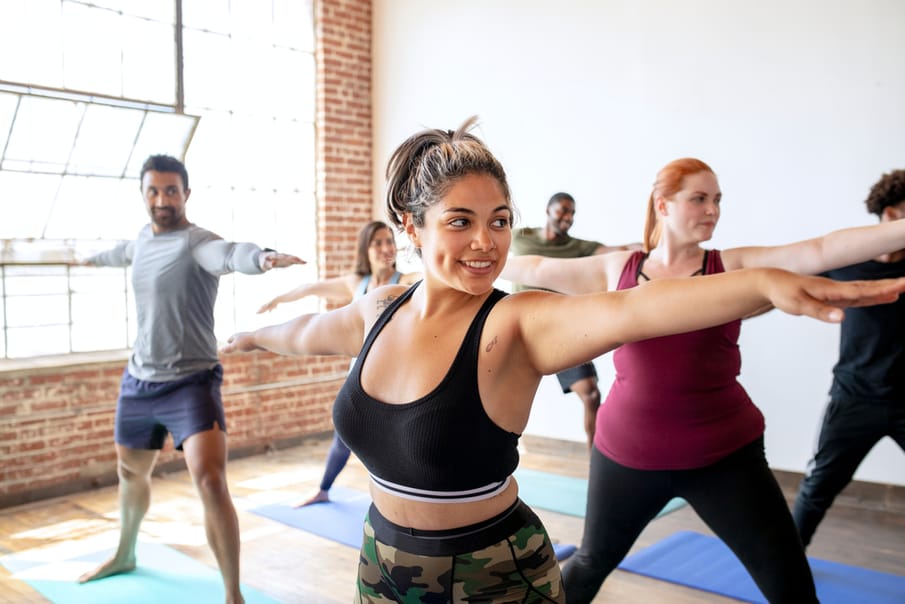What are the signs that you’ve signed up for a good yoga class?
Yoga can be hugely transformative for both our physical and our mental health. But not all classes are made equal. Here, we’re sharing five green flags – signs that you’ve found a great yoga class.
1. The teacher begins by asking if anyone has any injuries
An injury can affect the way that you are able to access a class, and certain positions could make that injury worse by putting pressure on the injured body part – for example, if you have a knee injury, you may want to be cautious around pigeon pose.
A lot of teachers will begin their classes by asking the group if anyone has any injuries. If this applies to someone, the teacher will then ask for some more details and will be able to offer advice on how to adapt poses, and they will likely check in with that student throughout the session, and support them with adjustments where needed.
A teacher ensuring they are aware of any injuries before a class starts not only means that they can help students take practical steps to modify their practice, but is also a sign that the teacher is taking their duty of care for their students seriously.
2. The teacher asks for permission before adjusting students’ form
Help with adjusting your form is one of many benefits of going to an in-person class. It can help you improve your practice, as well as avoid injury. That said, not everyone is comfortable with physical touch, and others may be OK with some forms and not others. A teacher who takes a moment to ask for permission before physically adjusting a student’s form is making consent a priority, and creating a respectful and supportive environment.
Different teachers may take different approaches to this. Some may have tags that they offer out at the start of the class – some that they touch is OK and others that say it is not. Others may ask for a show of hands, who would prefer not to be touched, before beginning, and some may quietly ask each individual as they walk around the room. Where a student does not want to be touched, the teacher can then provide verbal instructions or demonstrations instead.
3. Modifications for different bodies
Despite what social media may have us believe, yoga is for every body. Each of us has a different range of motion and differing abilities, and so one yoga pose may look completely different from person to person. But the key thing is, that doesn’t mean that it’s wrong.
In an inclusive yoga class, the teacher will provide modifications, sometimes two or three versions, of the same poses. This may include the use of equipment such as yoga blocks, straps, and blankets or positioning on your body. For example, in a forward bend, one person may place their hands around their ankles, another on their shins, and another on their knees.
4. Neutral language around bodies
For some people, stepping into any kind of exercise class can feel intimidating as we wade through heavy expectations around what our bodies should look like and how they should work. Using deliberately neutral language around the ways our bodies move in a yoga class is a sure sign that you’re in a safe environment.
For example, questions and anxiety around flexibility can be something that comes up a lot in yoga – but a flexible body is certainly not a requirement. Using phrases such as ‘those who have tighter bodies’ rather than ‘those who are less flexible’ takes the judgement out of modifications, and teachers may also put emphasis on doing ‘what feels right today’ in acknowledgement of the ways our bodies move differently from class to class.
5. Your instincts are telling you you’re in the right place
There a definitely a lot of standard good practice signs that you can mentally check off when you attend a yoga class, but you will probably get the best idea of whether that class works for you or not by simply listening to your instincts.
Do you feel safe? Supported? Do you feel accepted and respected? Are you able to focus on your practice? Do you feel comfortable and confident?
An important component of yoga is tuning in to yourself, so use this skill to assess what your instincts are telling you. What makes a ‘good’ yoga class will vary from person to person. For some, a chatty and personal class is ideal, others may want a more quiet and reflective environment. So, think about what it is that works, and doesn’t work for you. Your preferences are valid, and your intuition is a powerful tool – listen to it.
Learn more about yoga and find a yoga therapist on Therapy Directory.


Comments